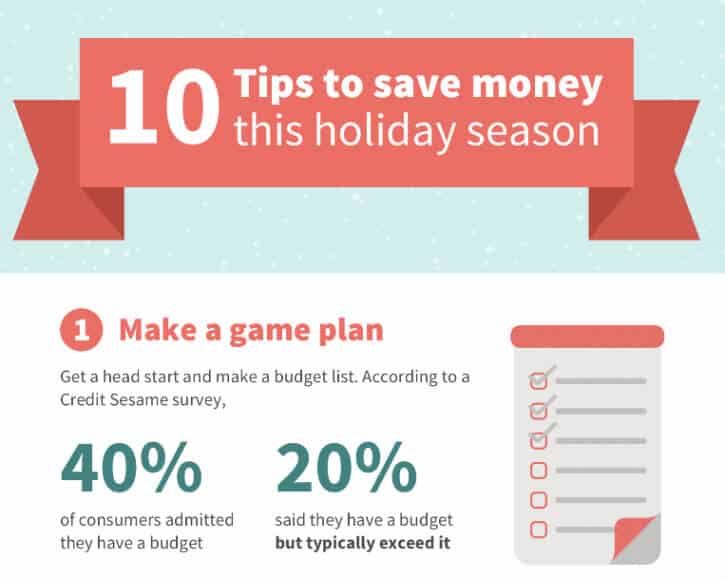I worked my way through college with a department store job, specifically in their Home Store. My first day was in early September and my task for the day was to unpack dozens of boxes of ornaments and Christmas tree decorations.
When I asked my coworkers why we were putting up holiday items so early, they said something I’d hear hundreds more times over the years: “one month to set up, three months to sell.” They’d actually put the trees and snowman dish displays in mid-August; I walked past them several times during the hiring and interview process.
According to a recent survey from Credit Sesame, more than 38% of respondents have a holiday budget. That’s awesome! But even more exceed their budget or have no budget at all.
Retailers capitalize on this prime shopping time by offering us some great (and not-so-great deals). Be aware of some of their favorite strategies to increase the number of dollars that are transferred from your wallet into their cash register!
Here are some tricks of the trade.
1. Unrealistic holiday displays the stores want you to recreate at home

Store displays are designed to entice you to buy more so that you can recreate their picture perfect displays in your home. Far too often, customers buy more lights, ornaments and soon-to-be-forgotten dishes than they need or can realistically use.
Who needs, or has time to put up, 20 sets of lights on an 8-foot tree? This is no exaggeration. I spent a whole morning just putting lights on one tree. And when was the last time you used, or even wished that you had, a deviled egg dish to match your holly berry dish set?
Don’t fall for this spending mind trick.
2. Bulk pricing
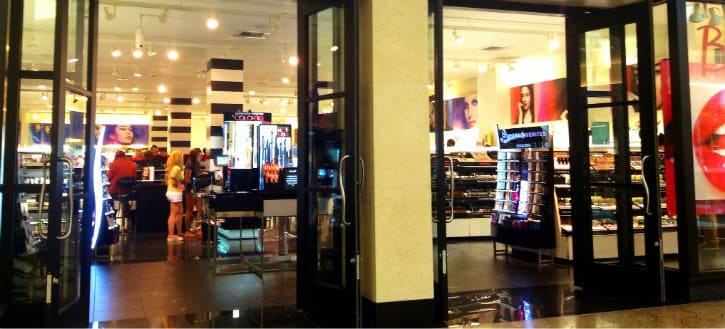
Bulk discounts are not exclusive to warehouse stores. Department stores offer discounts for multiples all the time. Why buy just one pair of snowman socks for $1.99 when you can get 10 for $10? The sign tells you that “they make great stocking stuffers!”
Never mind that you don’t need to fill ten stockings. You can probably buy one pair for each of your children and still come out ahead.
Only buy what you need, and don’t get sucked into buying in bulk.
3. A sense of urgency and scarcity

Today only! While supplies last! Many a shopper (including yours truly) has made an unplanned purchase after finding out that the price is good for “just four more hours.”
This common psychological selling tactic will be employed in full-force on Black Friday, Small Business Saturday and Cyber Monday.
Shoppers are further lured into deals when there’s a “limit of two per household.” The scarcity mindset makes you all the more likely to buy more than you planned to buy, simply because you want to get your share. Better to look up thrifting blogs to get a better sense of discounts you may find.
4. Decoy products to make another product look like a better deal

Two red v-neck sweaters are on an aisle display. At first glance, they’re identical. Then you see the signs: the larger sign says that one sweater is priced at $69.99 and there, tucked between the stacks of sweaters, is another sign showing that the other sweater is just $29.99.
The higher-priced sweater is a designer label, the decoy, while the other is the store’s own brand. The store isn’t looking to sell as many of the designer item; they placed it next to the lower-priced sweater so the store brand appears to be a great deal.
If you were out searching for a sweater, this might be one to buy. But even if you didn’t enter the store intending to buy a sweater, there’s a good chance that the decoy pricing will inspire you to pick one up.
Also, the lower-priced sweater was probably always sold for this price, and even less with a coupon. If you really want to deal-shop, watch sales prices on the store’s website to see how they fluctuate in the weeks before you buy. You might find that you can get the name brand sweater for the lower price by paying attention and watching for coupons.
5. Chatty social sales associates
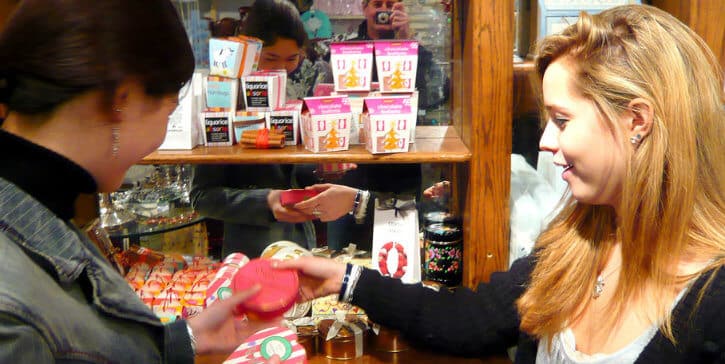
Any sales associate knows that store and department sales goals are important. Job security requires that they do their best to see that the goals are met. This is even truer for folks who work on commission. Employees want to be seen as a good team player, so they follow their manager’s requests to be chatty and helpful with customers.
I purchased items I sold, and frequently heard back about products from regular customers, so I was often able to tell some anecdote about a product that a customer was considering. Many times, they’d take my word and buy it.
I wasn’t on commission and I genuinely wanted to be helpful, but that doesn’t change the fact that my demeanor surely persuaded some people to go over budget when I displayed enthusiasm for certain products. The National Retail Federation says consumers admit that they can be swayed into purchasing more by great customer service.
6. Hard-to-find clearance bins

Many savvy shoppers like to hit the clearance bins, but during the holiday season you’ll be lured past more regular-priced items than usual to find the assortment of last season’s merchandise.
Stores put clearance items in the far back corners so that the shiny, new items get the best shelf space and attention before you ever even get a chance to dig.
Have patience. Clearance stock will be front and center the day after Christmas, so that there will be less inventory to count come January and February.
7. ‘Open-the-wallet’ displays while you stand in line for the register

The store where I worked had a knack for designing elaborate tiered displays to place in the most annoying places: at the store entrance, in the aisles, near the customer service desk and right next to the restrooms.
The items on display weren’t money makers, but rather nice but inexpensive items like chocolates, candles, socks or commemorative ornaments that were easy and painless to purchase.
“Wow! Luxury chocolate bars for $2.49. I’ll pick up a few for the office,” you think as you grab some. That quick decision opens up your willingness to purchase more. “Well, I’m already buying these chocolates. I might as well go see what they have in the children’s section and get some more shopping done.”
8. Blocked aisles

You walk in the store, list in hand, heading straight to your desired location. Although the aisles are clear, you suddenly hit a log-jam of people. You’ve come to a roadblock, a display or merchandise table designed to get you to slow down as you navigate around.

As you do this you tend to pay more attention to your surroundings, which leads you to look at the items off to the side or the display itself. Being interrupted while you shop makes you 35% more likely to buy the item that’s blocking the way, or a nearby item that catches your attention. These aisle-blockers aren’t limited to products. They also come in the form of large signs.
9. Free samples
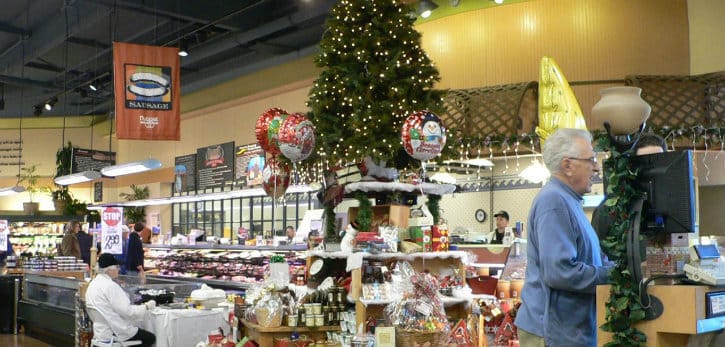
Free samples aren’t limited to food and beverages. Perfume spritzers, trial size lotions and tiny packages of expensive face creams are a few of the items that are handed out more freely at this time of year.
They are, of course, meant to inspire you to buy something that probably wasn’t on your list, just because it is so wonderful. To resist the temptation to even accept a sample, say that you can’t eat it, don’t use that brand of product, have allergies, or simply, “no, thank you.”
10. Holiday ambiance

Think about cinnamon scented candles or potpourri. You catch a whiff of it as you walk in the store to pick up a gift for your father-in-law. Your mind takes you right back to winter at Grandma’s, drinking spiced cider and playing with your new Lego set. You feel all warm and fuzzy inside and resolve to create memories like that for your children. You make a beeline for the Lego aisle, even if their presents are already purchased and wrapped.
From the holiday music coming from the sound system to the displays of holiday scented candles and the dozens of themed trees and winter holiday displays to the potpourri placed throughout the store, stores go to great lengths to make you feel festive and nostalgic. Getting you into that holiday mood makes you more apt to buy up to 17% more than you’d planned, according to research done by Martin Lindstrom, author of “Brandwashed: Tricks Companies Use to Manipulate Our Minds and Persuade Us to Buy.”
11. Store card discount

Every month I was tasked with signing up at least two customers for a store credit card (for which I received a whopping $2 per card that was successfully opened). My opening phrase was, “Would you like to save an extra 10% on all of your purchases today?” This simple question often enticed customers to ask for more details.
Or I’d point out that their coupon couldn’t be used on the Nike clothes in their cart, but they could get a discount by opening a credit card account. The discount, valid for one day only (remember: scarcity and urgency), was good on nearly everything, including many items usually excluded from sales and coupons, and could be used in conjunction with the coupons they already planned to use.
In response, many customers ran back to a shelf to get another item, or went on to another department to load up more merchandise and take greater advantage of the discount.
Since more than 14% of the respondents in Credit Sesame’s survey said they will pay for holiday items with credit cards but not pay them off the following month, this is not a money-saving strategy for all. You get a discount up front, but you’ll pay it back and more on the back end in double-digit interest rates.
Shop Smart
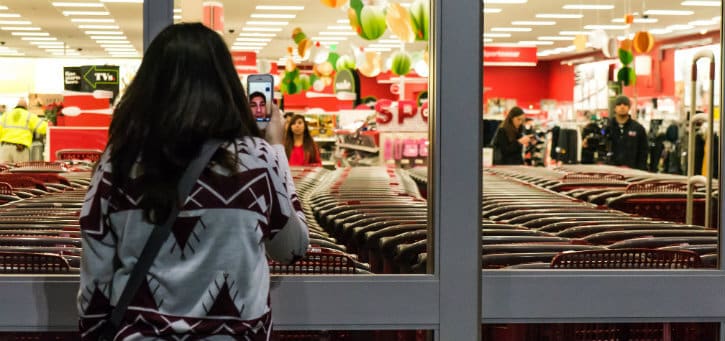
Here are my tips to help you be among the Credit Sesame readers who stay within their holiday budgets this year. Do these before you hit the mall or log on to your favorite store websites.
- Make a list of recipients
- Decide on a dollar amount for each person
- Brainstorm gift ideas and where you’ll find the items
- Search online ads for great deals
- Look for coupons and rebates
- Write name of the recipient on each receipt so you can easily tally up the total spent on each person
If you put up your guard, you can avoid buying things you don’t want or need, or that fall outside your budget. Protect your wallet and your credit by doing the work to find a good deal on products that you want to buy as gifts versus products that are pushed on you by clever psychological marketing tactics.
